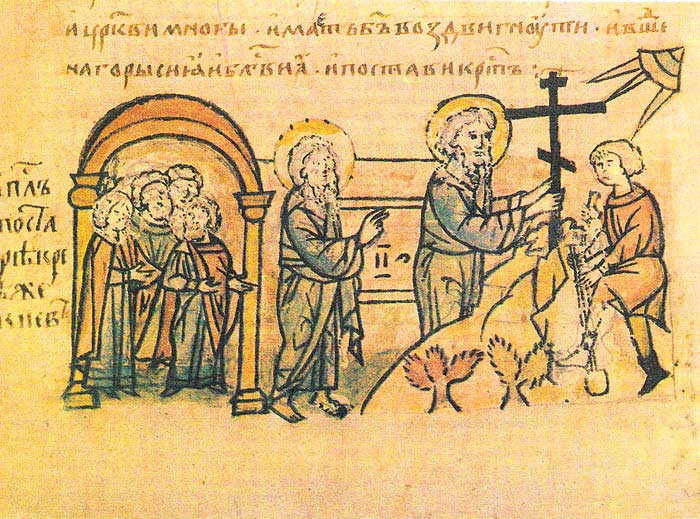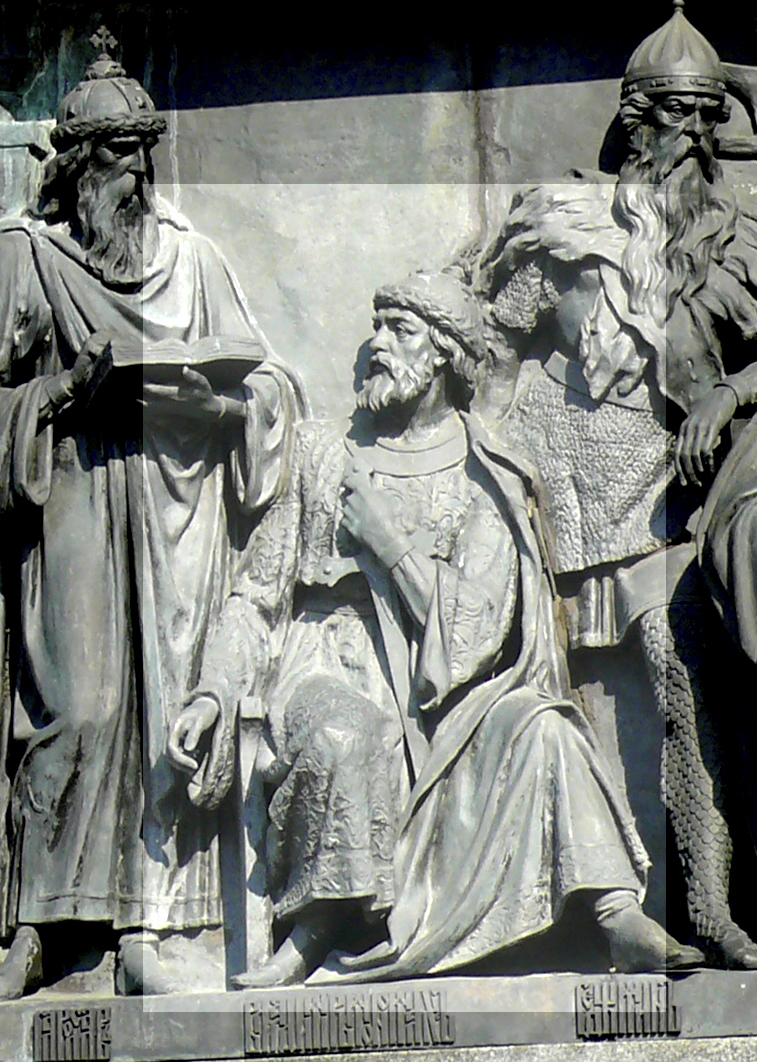|
St Andrew's Church Of Kiev
St Andrew's Church ( uk, Андріївська церква, ''Andriivska tserkva'') is an Orthodox church in Kyiv, constructed between 1747 and 1754 to a design by the Italian architect Bartolomeo Rastrelli, a rare example of Elizabethan Baroque in Ukraine. Situated on a steep hill, where Andrew the Apostle is believed to have foretold the great future of the place as the cradle of Christianity in the Slavic lands, the church overlooks the historic Podil neighborhood. Since 1968, the building has been a museum, part of the National Sanctuary "Sophia of Kyiv" as a landmark of cultural heritage. At the beginning of the 21st century the building faced serious problems due to the unstable foundation and it underwent major renovation at the end of the 2010s, after it was gifted to the Ecumenical Patriarchate of Constantinople. Location The church was consecrated in honor of Andrew the Apostle who is recognized as the " Apostle of Rus′". [...More Info...] [...Related Items...] OR: [Wikipedia] [Google] [Baidu] |
Andriyivskyy Descent
Andrew's Descent ( uk, Андріївський узвіз, ) is a historic descent connecting Kyiv's Upper Town neighborhood and the historically commercial Podil neighborhood. The street, often advertised by tour guides and operators as the "Montmartre of Kyiv", is a major tourist attraction of the city. It is included in the list of national landmarks by the government resolution. In addition, the street is also part of the Kyiv city historic reserve " Ancient Kyiv", while the St.Andrew's Church belongs to the National historic reserve " Sophia of Kyiv". The descent, in length, is constructed of laid cobblestones and connects Old Kyiv (Upper city) with Podil (Lower city). It starts at the end of Volodymyrska Street and winds down steeply around the Zamkova Hora hill, ending near the Kontraktova Square. Andrew's Descent is marked by a couple historic landmarks, including the Castle of Richard the Lionheart, the 18th century baroque Saint Andrew's Church, famed Russian writ ... [...More Info...] [...Related Items...] OR: [Wikipedia] [Google] [Baidu] |
Pechersk, Kyiv
Pechersk ( uk, Печерськ) is a historical neighborhood in the city center of Kyiv, the capital of Ukraine. It is a part of the administrative Pechersk Raion (district). Pechersk is located between the Lypky, Klov and Dnieper hills. Its main streets are Ivan Mazepa Street, Dmytro Godzenko Street, and Lesya Ukrainka Boulevard. History Its name comes from the caves of Kyiv Pechersk Lavra (founded in 1051) existing since ancient times. The settlement began to emerge in the 12th century as the Pechersk Lavra settlement including areas around the former village of Berestove. In 16-17th century, Pechersk was a town. Construction of Old Cave Castle (the administrative center of Kyiv) began in the 1st half of the 18th century followed by New Pechersk fortress 30 - 40 years later. In the 19th century, the settlement included the former settlement Vasylkivski Rogatky. Pechersk name can be found in the Raion, Square, Descent, Boulevard (now Lesya Ukrainka Boulevard), Street (no l ... [...More Info...] [...Related Items...] OR: [Wikipedia] [Google] [Baidu] |
Elizabeth Of Russia
Elizabeth Petrovna (russian: Елизаве́та (Елисаве́та) Петро́вна) (), also known as Yelisaveta or Elizaveta, reigned as Empress of Russia from 1741 until her death in 1762. She remains one of the most popular Russian monarchs because of her decision not to execute a single person during her reign, her numerous construction projects, and her strong opposition to Prussian policies. The second-eldest daughter of Tsar Peter the Great (), Elizabeth lived through the confused successions of her father's descendants following her half-brother Alexei's death in 1718. The throne first passed to her mother Catherine I of Russia (), then to her nephew Peter II, who died in 1730 and was succeeded by Elizabeth's first cousin Anna. After the brief rule of Anna's infant great-nephew, Ivan VI, Elizabeth seized the throne with the military's support and declared her own nephew, the future Peter III, her heir. During her reign Elizabeth continued the policies of he ... [...More Info...] [...Related Items...] OR: [Wikipedia] [Google] [Baidu] |
Pulpit In St
A pulpit is a raised stand for preachers in a Christian church. The origin of the word is the Latin ''pulpitum'' (platform or staging). The traditional pulpit is raised well above the surrounding floor for audibility and visibility, accessed by steps, with sides coming to about waist height. From the late medieval period onwards, pulpits have often had a canopy known as the sounding board, ''tester'' or ''abat-voix'' above and sometimes also behind the speaker, normally in wood. Though sometimes highly decorated, this is not purely decorative, but can have a useful acoustic effect in projecting the preacher's voice to the congregation below. Most pulpits have one or more book-stands for the preacher to rest his or her bible, notes or texts upon. The pulpit is generally reserved for clergy. This is mandated in the regulations of the Catholic Church, and several others (though not always strictly observed). Even in Welsh Nonconformism, this was felt appropriate, and in some c ... [...More Info...] [...Related Items...] OR: [Wikipedia] [Google] [Baidu] |
Kievan Rus'
Kievan Rusʹ, also known as Kyivan Rusʹ ( orv, , Rusĭ, or , , ; Old Norse: ''Garðaríki''), was a state in Eastern and Northern Europe from the late 9th to the mid-13th century.John Channon & Robert Hudson, ''Penguin Historical Atlas of Russia'' (Penguin, 1995), p.14–16.Kievan Rus Encyclopædia Britannica Online. Encompassing a variety of polities and peoples, including East Slavic, Norse, and Finnic, it was ruled by the , fou ... [...More Info...] [...Related Items...] OR: [Wikipedia] [Google] [Baidu] |
Mongol Invasion Of Rus'
The Mongol Empire invaded and conquered Kievan Rus' in the 13th century, destroying numerous southern cities, including the largest cities, Kiev (50,000 inhabitants) and Chernihiv (30,000 inhabitants), with the only major cities escaping destruction being Novgorod and Pskov, located in the north. The campaign was heralded by the Battle of the Kalka River in May 1223, which resulted in a Mongol victory over the forces of several Rus' principalities as well as the remnants of the Cumans under Köten. The Mongols retreated, having gathered their intelligence, which was the purpose of the reconnaissance-in-force. A full-scale invasion of Rus' by Batu Khan followed, from 1237 to 1242. The invasion was ended by the Mongol succession process upon the death of Ögedei Khan. All Rus' principalities were forced to submit to Mongol rule and became vassals of the Golden Horde, some of which lasted until 1480. The invasion, facilitated by the beginning of the breakup of Kievan Rus' in the ... [...More Info...] [...Related Items...] OR: [Wikipedia] [Google] [Baidu] |
Halych
Halych ( uk, Га́лич ; ro, Halici; pl, Halicz; russian: Га́лич, Galich; german: Halytsch, ''Halitsch'' or ''Galitsch''; yi, העליטש) is a historic city on the Dniester River in western Ukraine. The city gave its name to the Principality of Halych, the historic province of Galicia (Eastern Europe), Galicia (Halychyna), and the Kingdom of Galicia–Volhynia, of which it was the capital until the early 14th century, when the seat of the local rulers moved to Lviv. Nowadays, Halych is a small town located only on one part of the territory of the former Galician capital, although it has preserved its name. It belongs to Ivano-Frankivsk Raion (Administrative divisions of Ukraine, district) of Ivano-Frankivsk Oblast (Administrative divisions of Ukraine, region). It hosts the administration of Halych urban hromada, one of the hromadas of Ukraine. Halych lies north of the oblast capital, Ivano-Frankivsk. Population: . Name The city's name, though spelled identically ... [...More Info...] [...Related Items...] OR: [Wikipedia] [Google] [Baidu] |
Vsevolod I Of Kiev
Vsevolod I Yaroslavich (Russian: Всеволод I Ярославич, Ukrainian: Всеволод I Ярославич, Old Norse: Vissivald) (c. 1030 – 13 April 1093), ruled as Grand Prince of Kiev from 1078 until his death. Early life He was the fifth and favourite son of Yaroslav I the Wise by Ingigerd Olafsdottir. He was born around 1030. On his seal from his last years, he was named "Andrei Vsevolodu" in Greek, implying that his baptismal name was Andrew. To back up an armistice signed with the Byzantine Emperor Constantine IX Monomachos in 1046, his father married Vsevolod to a Byzantine princess, who according to tradition was named Anastasia or Maria. That the couple's son Vladimir Monomakh bore the family name of the Byzantine emperor suggests she was a member of his close family, but no contemporary evidence attests to a specific relationship and accounts of the Emperor give him no such daughter. Upon his father's death in 1054, he received in appanage the ... [...More Info...] [...Related Items...] OR: [Wikipedia] [Google] [Baidu] |
Grand Prince Of Kiev
The Grand Prince of Kiev (sometimes grand duke) was the title of the ruler of Kiev and the ruler of Kievan Rus' from the 10th to 13th centuries. In the 13th century, Kiev became an appanage principality first of the grand prince of Vladimir and the Mongol Golden Horde governors, and later was taken over by the Grand Duchy of Lithuania. Princes of Kiev Mythological rulers According to Slavophiles, Kyi ruled since 430, one of the dates attributed to the legendary founding of Kiev in 482, although that date relates to Kovin on the Danube in Serbia. Some historians speculate that Kyi was a Slavic prince of eastern Polans in the 6th century. Kyi's legacy along with Shchek's is mentioned in the Book of Veles, the authenticity of which, however, is disputed. Oleg, an apocryphal Kiev voivode, probably of Danish or Swedish origin, ruled under the overlordship of the Khazar Khaganate. Bravlin was a Varangian prince or chieftain, who led a Rus military expedition to devastate the C ... [...More Info...] [...Related Items...] OR: [Wikipedia] [Google] [Baidu] |
History Of Christianity In Ukraine
The history of Christianity in Ukraine dates back to the earliest centuries of the history of Christianity, to the Apostolic Age, with mission trips along the Black Sea and a legend of Saint Andrew even ascending the hills of Kyiv. The first Christian community on territory of modern Ukraine is documented as early as the 9th century with establishment of the Metropolitanate of Gothia centered in Crimean peninsula. However, on territory of the Old Rus in Kyiv it became the dominant religion since its official acceptance in 988 by Vladimir the Great (Volodymyr the Great), who brought it from Byzantine Crimea and installed it as the state religion of medieval Kyivan Rus (Ruthenia), with the metropolitan see in Kyiv. Although separated into various Christian denominations, most Ukrainian Christians share a common faith based on Eastern Christianity. This tradition is represented in Ukraine by the Byzantine Rite, the Eastern Orthodox and Eastern Catholic churches, which have been at v ... [...More Info...] [...Related Items...] OR: [Wikipedia] [Google] [Baidu] |
Dnipro River
} The Dnieper () or Dnipro (); , ; . is one of the major transboundary rivers of Europe, rising in the Valdai Hills near Smolensk, Russia, before flowing through Belarus and Ukraine to the Black Sea. It is the longest river of Ukraine and Belarus and the fourth-longest river in Europe, after the Volga, Danube, and Ural rivers. It is approximately long, with a drainage basin of . In antiquity, the river was part of the Amber Road trade routes. During the Ruin in the later 17th century, the area was contested between the Polish–Lithuanian Commonwealth and Russia, dividing Ukraine into areas described by its right and left banks. During the Soviet period, the river became noted for its major hydroelectric dams and large reservoirs. The 1986 Chernobyl disaster occurred on the Pripyat, immediately above that tributary's confluence with the Dnieper. The Dnieper is an important navigable waterway for the economy of Ukraine and is connected by the Dnieper–Bug Canal to other w ... [...More Info...] [...Related Items...] OR: [Wikipedia] [Google] [Baidu] |


.jpg)




